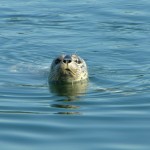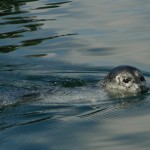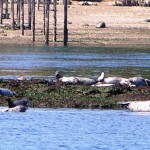Pacific Harbor Seal – Poca vitulina richardsi
Size: Greater than 6 feet; up to 375 lb
Range: Coastal areas of the north Pacific region
Habitat: Mainly near shorelines; adults will stray further and individual seals even foray into inland rivers and even lakes
Food: Fish, shellfish, crustaceans
The Most Common Marine Mammal in the World
Whales and dolphins get all the publicity. After all, cetaceans are clever, fascinating animals. But Pinnipeds are pretty interesting mammals of the marine world, too. And for the naturalist they present observational opportunities no dolphin will give you. To begin with seals and sea lions are a lot more accessible than their echo locating cousins and they aren’t under water ninety percent of the time. And they are one of the few wild animals I know that seem to like watching humans as much as we like to watch them.
There are also a lot more of them. Harbor Seals, in fact, are the most plentiful marine mammal in the world. Up and down the northern parts of the US East and West coasts, into Asia, and all along northern European oceans you can find one or more of the five sub species of Harbor Seals. The world wide population is estimated at up to half a million, with 350,000 of them found along the Pacific Coast. This is hardly an endangered animal. Which is probably the reason they don’t get star billet on the big nature shows – there’re just so danged many of them.
The Eagle Island Population
I admit that I was once as blasé about harbor seals as the next guy. The price of gas, however, bit into my long range boating explorations. But by then my wife and I had found a beautiful little spot not too far from our marina in Puget Sound, called Eagle Isle. Named for the Bald Eagles that call it home the little bit of rock, sand, and Douglas Firs is also a favored hang out for a population of Harbor Seals.
From the first time we anchored it was impossible not to notice the seals. More than fifty of them constantly swim near the island and hover around a shoal to the west. The shoal is an exceptionally favorite spot. Visible only during unusually low tides the shoal presents a hazard to boaters, but it suits the harbor seals just fine. It was during one of these low tides that I first witnessed a harbor seal haul out and began to observe them in a more disciplined manner.
Exceptional Curiosity
Harbor seals are very curious animals, but at the same time quite timid. They seem torn between an intense desire to investigate anything new and a hobbit like reluctance for adventure. I noted that every time we anchored the boat they watched us with great intensity, moving closer and closer and then stopped. About one hundred feet seemed to define the threshold for their desire to learn more about us.
Behavior Above Water
The majority of the seal’s time is spent floating effortlessly at the surface. They float this way holding several postures. The most common is the head up or “bottling” posture. The head is above the water and parallel to the surface. The rest of the body is positioned straight down into the water. A variation on the bottling posture is what I call the nose to sky position. For reasons of their own the seals will point their nose directly upward as though looking at the sky.
Not as common (though by no means rare) as the bottling posture are full body postures. A seal in this position exhibits the head above the surface and the upper part of the back as well. Often just the head and the flippers break the surface.
The seals can reportedly dive to 300 feet and stay under for half an hour. While I cannot confirm that I can tell you that the seals have several unique methods of diving. The most favored, especially when frightened, is the porpoise like plunge in which the head goes under followed by the curving arc of the back. At other times they will slip just the head underwater in a forward motion; sometimes they point the nose upward and submerge to the rear.
Unlike us humans seals exhale prior to a dive. We store oxygen in our lungs; marine mammals store it in their blood and tissues. Oddly enough though, they exhale again quite loudly upon surfacing. I’ve also observed the seals exhaling repeatedly after a dive, making a sound resembling a soft, horse like snort. This exhalation is repeated just about every two seconds for some time.
Curiosity Triumphs
Your ads will be inserted here by
Easy Plugin for AdSense.
Please go to the plugin admin page to
Paste your ad code OR
Suppress this ad slot.
It is the curiosity of harbor seals that I find most fascinating and most endearing. Not unexpectedly it is the youngsters that most exhibit this trait. Harbor seal pups in this part of their range are born June through July. Mom feeds the little one for three to six weeks. By September they are swimming on their own, but tend to stay in small groups of four to six. In my experience this is when the seals enter the most curious phase of life.
I’ve watched these young seals stare intently at our boat for long periods of time and swim closer and closer. Occasionally a daring individual will approach closely, then dash by the boat underwater. They exhibit an uncanny knack for sneaking up behind while you are looking in another direction. Suddenly you hear an exhalation and a spash. Your turn and see turbulent water not ten feet away. But patience eventually pays off. On one memorable day a young seal’s curiosity finally overcame his timidiy. He swam right up to the boat ladder and touched his nose to it. The noise woke my wife. I don’t know who was more surprised, her or the little seal.
Underwater Observations
The notoriously cold waters and swift tide currents of Puget Sound are not conducive to unprotected humans. I dove in once wearing nothing but a pair of shorts and it is not an experience I want to relive. With a proper wet suit and knowledge of the tides, however, the Sound offers excellent diving and snorkeling. And wet suited humans are very intriguing objects to harbor seals.
While snorkeling and taking some photos one I noticed a small group of young seals some distance away. Ten pairs of liquid black eyes were riveted on me. At that point the seals were maintaining their customary safe distance so I continued to hover in the water observing the depths beyond my flippers. I was hoping one of them would come to me investigate since it is illegal to approach any marine mammal to less than one hundred yards. Suddenly an enormous silver blue shape emerged from the gloom. At first I thought I was seeing some marine monster about to swallow me whole. I was startled to put it mildly. But as it approached me the shape was unmistakable. One of the young seals had decided to investigate.
The little fellow circled under me, about fifteen to twenty feet away. It swam in a canted position and watched me while almost turned upside down. In relatively slow, easy circles the seal observed me for about five minutes and disappeared. I thought the show was over, but he in a short time he returned with a friend. Both animals resumed a circular observation almost making me dizzy as they looped around and around.
Watching them underwater is a beautiful experience. Blue green shadows that move like water ghosts, they exhibit a grace and ease the envy of any diver. Unlike sea lions, seals propel themselves with their rear flippers. Pushing against the water in a lazy, almost figure eight motion only the flippers and a small portion of their rear body moves. The smaller front flippers were held tightly against the torso; they looked more like clawed paws than flippers from my angle. The pair kept an eye on me for several minutes, then, as if they both agreed that they’d seen enough, they disappeared. I saw them pop up with the rest of the gang and I could swear they were undergoing a de-briefing by the other seals.
Why Not Do It Yourself?
Observing harbor seals is a great way to introduce children to natural history. This is an easily accessible interesting marine mammal with a wide assortment of behaviors. Besides what I have described above your observations might include the following:
What sounds do they make?
What is their behavior on land?
How do they move on land?
Time the length of a dive and the distance of a dive
How can you tell the differences between individuals?
Do they eat above the surface or below?
How many seals can you count in a given area?
At what time or tide are they most active?
The possibilities are too numerous to list. Remember, no matter how “common” we think an animal appears every one is fascinating example of life filled with complex behaviors.
HOOAH
Jack




Leave a Reply
You must be logged in to post a comment.